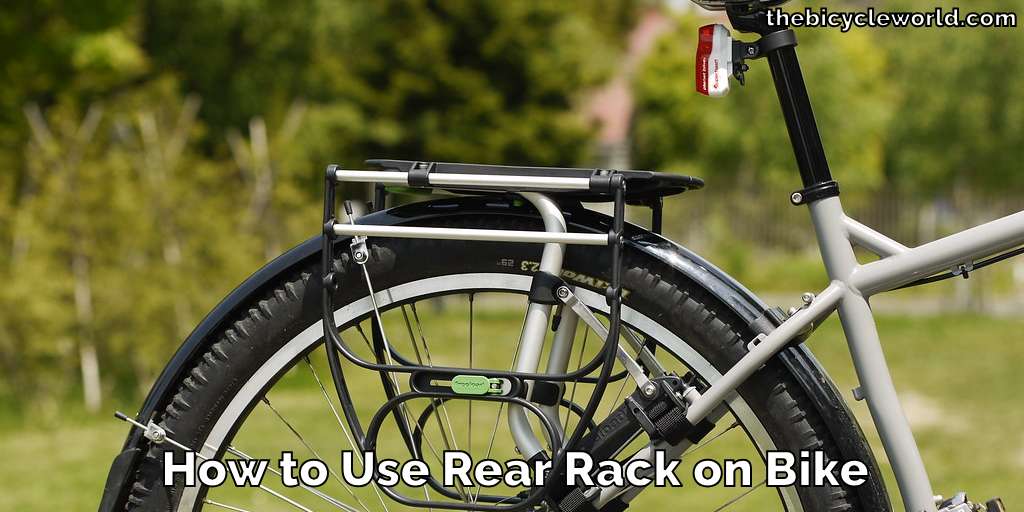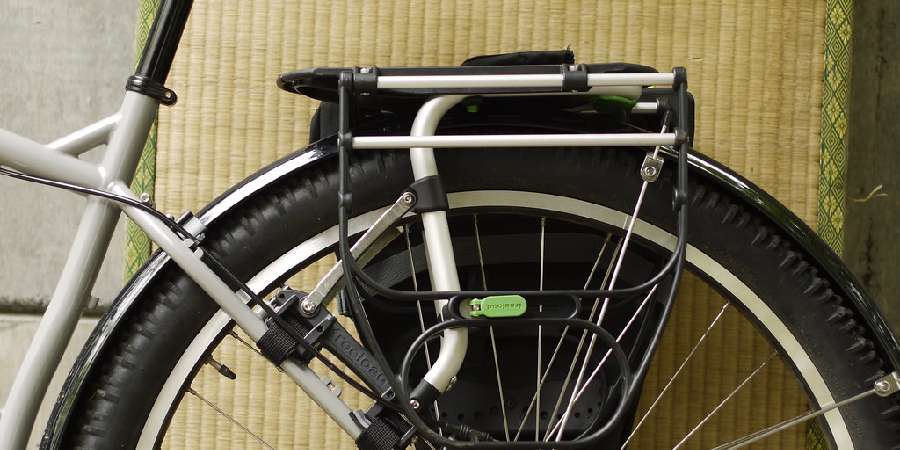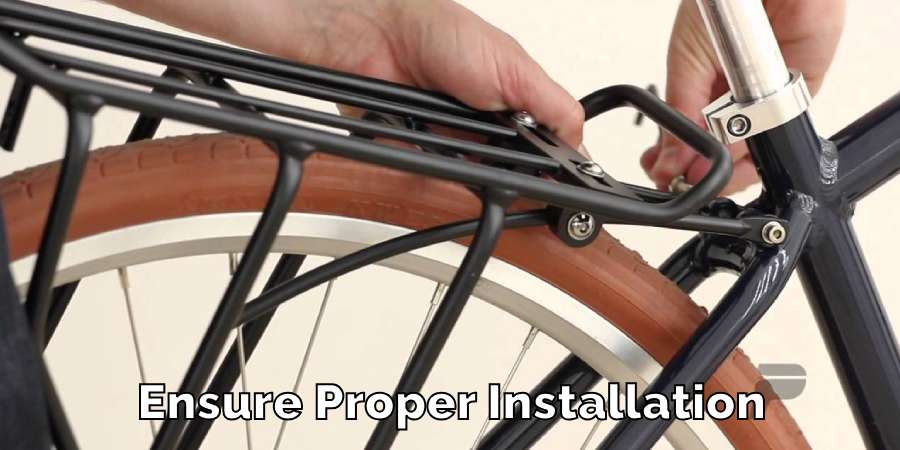How to Use Rear Rack on Bike
Introduction
Biking is much more than just a way to get from one place to another it’s a way of life. Adding a rear rack to your bike can significantly increase its functionality. This simple accessory turns your bike into a multi-purpose vehicle, ideal for various activities.

Whether you’re going to work, doing some shopping, or even planning a small outdoor adventure, a rear rack makes these tasks easier and more efficient. In this guide, we’ll show you how to get the most out of your rear rack, making your biking experience not only more practical but also more enjoyable.
Let’s look at how to use rear rack on bike to enhance your biking adventures and daily routines.
Understanding Rear Racks
Rear racks are a simple yet effective addition to any bicycle, enhancing its utility in numerous ways. They are designed for anyone who needs extra carrying capacity, whether for daily use or special outings.
What is a Rear Rack?
A rear rack is a durable frame attached to the back wheel of your bicycle. It’s designed to hold different items securely as you ride. Think of it as a helpful addition to your bike that can carry your groceries, work items, or gear for a day out.
Types of Rear Racks
Rear racks come in various styles, each made to fit different kinds of bikes and serve different needs. For example, some are built for lightweight, everyday items, while others are made for heavier loads, perfect for long trips or big shopping hauls. There are even specialized racks designed for specific bike types like mountain bikes or road bikes.

Benefits of Using a Rear Rack
Adding a rear rack to your bike opens up a whole new world of possibilities. For one, it greatly increases how much you can carry, freeing you from the limits of a backpack or handbag. This makes rear racks fantastic for everyday tasks like shopping or carrying your work essentials.
They’re also ideal for longer trips, like weekend adventures or touring, where you need to take more with you. With a rear rack, your bike becomes a more practical and versatile mode of transport, making your life on two wheels easier and more enjoyable.
Rear racks are a versatile and essential accessory for cyclists looking to increase their bike’s carrying capacity. Whether it’s for daily chores or special adventures, a rear rack adds huge value to your biking experience, making every ride more convenient and enjoyable.
How to Use Rear Rack on Bike
A rear rack on your bike can make a huge difference in how you use your bike, turning it into a more functional and versatile tool for various activities. From carrying your daily essentials to handling your shopping needs, a rear rack adds convenience to every ride.
Step-by-Step Guide to Using a Rear Rack:
Ensure Proper Installation
Before using your rear rack, make sure it is properly installed and securely attached to your bike. This is crucial for both safety and functionality.

Learn to Load Correctly
Loading your rack correctly is essential for maintaining balance. Place heavier items at the bottom and near the center of the rack. This helps keep your bike stable, even when carrying extra weight.

Use Accessories for Secure Carrying
Equip your rack with accessories like panniers or bungee cords. Panniers are bags specially designed for bike racks, and bungee cords help keep your items from falling off during your ride.
Avoid Overloading
Be mindful of the weight limit of your rear rack. Overloading can damage your rack or bike and make riding unsafe.

Adjust Your Riding Style
Carrying a load on your rack may require changes in how you ride. Ride steadily, take turns gently, and be more cautious to maintain your balance.
Regularly Check Your Load
Before and during your ride, regularly check to ensure everything is still securely attached and in place.
By following these steps, you can effectively utilize your rear rack, enhancing your biking experience significantly. Whether it’s a day at work, a shopping trip, or a weekend adventure, a rear rack makes your bike a more valuable and efficient companion.
Choosing the Right Rear Rack
Selecting the best rear rack for your bike is a crucial decision that can greatly enhance your biking experience. It’s not just about picking the first rack you see it’s about finding the one that suits your specific needs and bike.
Factors to Consider
- When you’re in the market for a rear rack, there are several important factors to keep in mind. First, think about the material of the rack. You want something that is strong enough to hold your items but not so heavy that it makes your bike hard to handle. Aluminum racks are a popular choice because they are both sturdy and lightweight. Next, look at the weight capacity of the rack. It’s important to know how much it can hold, especially if you plan on carrying heavy loads. A rack that can carry more weight is useful, but remember that a heavier load will also affect your riding. Finally, consider how easy it is to install the rack. Some racks can be attached with simple tools and minimal effort, while others might require more time and specific tools.
Compatibility with Your Bike
- It’s also essential to make sure the rack fits your bike. Not all racks are suitable for all bikes, so check if the rack can be securely attached to your bike model and size. A well-fitted rack should be stable and not wobble or shake as you ride.
Installation of a Rear Rack
- Tools Needed: To install a rear rack, you’ll generally need some basic tools like a wrench and a screwdriver. These tools will help you attach the rack securely to your bike.
- Step-by-Step Guide: It’s a good idea to follow a detailed guide or instructions when installing your rack. This usually involves attaching the rack to the frame of your bike at several points to ensure it’s stable and secure.
Packing and Loading the Rack
- How to Balance Load: Properly balancing the load on your rack is key to a stable ride. Place heavier items at the bottom and try to distribute the weight evenly across the rack.
- Tips for Secure Packing: Use straps or bungee cords to keep your items securely in place. This is especially important if you’re riding on bumpy roads or taking sharp turns, as you don’t want your items to shift or fall off.
By considering these factors and following these steps, you can choose and use a rear rack that not only fits your bike perfectly but also meets your carrying needs, whether it’s for daily commuting, grocery shopping, or longer trips. A well-chosen rear rack can make your bike more practical and versatile, enhancing your overall biking experience.
Maintenance and Care
Taking care of your rear rack is important to ensure it remains a reliable part of your bike over time. Just like the rest of your bike, your rear rack needs regular attention and maintenance.
Regular Checks and Adjustments
It’s important to regularly check your rear rack for any signs of loosening or damage. This means looking over all the bolts and connections to make sure they are tight and secure. If you find any parts that are wearing out or damaged, it’s best to fix or replace them as soon as possible. This not only keeps the rack safe but also helps prevent any potential accidents or damage to what you’re carrying.
Cleaning and Storage Tips
Keeping your rack clean is another key part of its maintenance. Dirt and grime can cause wear over time, so wiping down your rack regularly can help keep it in good condition. When you’re not using your bike, store it in a place where it’s protected from harsh weather conditions. This helps prolong the life of both your bike and the rack.
Safety Considerations
Weight Limitations
Every rear rack has a weight limit, and it’s crucial to adhere to this limit. Overloading your rack can lead to accidents and damage to your bike. Always check the manufacturer’s specifications for the weight limit and plan your load accordingly.
Riding with a Loaded Rack
When you have a loaded rack, it changes the way your bike handles. The extra weight can affect balance and steering. It’s important to get used to how your bike feels with the rack loaded, especially if you’re carrying heavy items. Practice in a safe area before heading out on busier roads.
Advanced Uses of Rear Racks
Long-Distance Touring
Rear racks are incredibly useful for long-distance touring. They allow you to carry all the essentials you need for extended trips, such as camping gear, clothing, and food supplies. Learning how to pack efficiently and balance the load is key for long journeys.
Creative Uses
There are many innovative ways to use your rear rack in everyday life. From attaching baskets for grocery shopping to special carriers for pets, the possibilities are nearly endless. Get creative and see how your rear rack can make your daily tasks easier and more fun.
Troubleshooting Common Issues
Dealing with Imbalance
If you ever find your bike feels unbalanced while riding, it could be due to how the load is distributed on the rack. Take the time to adjust your items, ensuring the weight is evenly spread out.
Addressing Wear and Tear
Regular maintenance, like tightening bolts and replacing worn parts, is crucial to keep your rack in top shape. If you notice any rust or serious damage, it might be time to consider getting a new rack.
By properly maintaining and caring for your rear rack, and being mindful of safety considerations and its potential uses, you can greatly enhance your biking experience. Whether it’s for daily commutes, shopping, or adventurous trips, a well-maintained rear rack is an invaluable asset for any biker.
FAQ’s
How Do Rear-mounted Bike Racks Work?
Rear-mounted bike racks are simple yet effective. They attach to the back of your bike, usually over the rear wheel, using clamps or bolts. These racks are designed to carry items, from groceries to gear. You can place bags, baskets, or panniers on them, securing them with straps or bungee cords. The rack’s sturdy design distributes the weight evenly, ensuring your bike remains balanced and easy to handle.
What is the Rack on the Back of a Bike Called?
The rack attached to the back of a bike is commonly known as a rear rack or a luggage carrier. It serves as a practical addition for carrying items, making your bike more versatile for different uses. Whether you’re commuting, shopping, or going on a long ride, a rear rack can hold your essentials securely.
Can Someone Sit on the Rear Rack of a Bike?
While rear racks are strong and can hold significant weight, they are not typically designed for carrying people. It’s usually unsafe for someone to sit on a rear rack because it can affect the bike’s balance and handling. However, specific child bike seats can be mounted on certain rear racks, designed for safely transporting children.
How Do You Secure a Rear Bike Rack?
Securing a rear bike rack involves a few key steps:
- Choose the Right Rack: Ensure the rack is compatible with your bike’s make and model.
- Gather Tools: Usually, a wrench and screwdriver are needed.
- Attach Firmly: Follow the manufacturer’s instructions to attach the rack to the bike frame, usually at the seat stay and near the rear axle.
- Check Stability: After installation, give the rack a wiggle to make sure it’s firmly in place.
- Regular Maintenance: Regularly inspect and tighten the bolts to ensure ongoing security.
What’s the Point of a Back Rack?
A back rack, or rear bike rack, adds tremendous utility to your bike. It allows you to carry items efficiently without affecting your riding comfort. This versatility makes your bike suitable for various activities, including commuting, shopping, touring, and more. With a rear rack, your bike becomes a more functional mode of transport, capable of carrying more than just the rider.
Conclusion
Adding a rear rack to your bike is a simple yet transformative change. It turns your bike into a versatile tool, perfect for daily tasks like commuting and shopping, or even for longer adventures. A rear rack means carrying more with ease, making your ride smoother and freeing you from the burden of a heavy backpack.
It’s an affordable upgrade that boosts your bike’s usefulness without needing big changes. Plus, it’s a step towards eco-friendly living, encouraging bike use over car trips.
Remember, every bike ride starts with a single pedal stroke. With a rear rack, each journey becomes more convenient and enjoyable, opening up new possibilities for your biking experiences. This article has explored how to use rear rack on bike.






